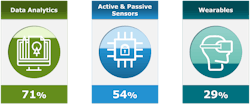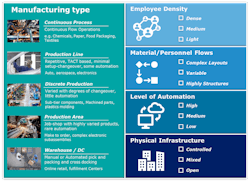Which Smart Factory Initiatives Will Lead the Recovery?
COVID-19 is changing everything in manufacturing. Companies face a long journey to the “next normal,” one that will likely have far-reaching financial and operational implications. Immediate priorities include creating a safe work environment for production employees, and this is top of mind for manufacturing leaders. Missteps could invoke legal or regulatory actions, something all companies want to avoid.
As many manufacturers enter the Recover phase of COVID-19, one that is marked by restarting production at plants in regions that have been impacted differently by virus outbreaks, workforce safety becomes a critical priority. The restart/ramp-up should generate considerations across the work itself, the workforce, and the workplace. Production leaders could consider the following types of questions to help them navigate workforce safety and develop a comprehensive plan through this period:
Work: How will new physical distancing constraints and supply/demand variability be incorporated into operations? Are there opportunities to remove humans from processes through automation and/or robotics?
Workforce: How will workers “feel” safe and come back to work willingly? What new policies and procedures are required to protect employees, reduce risk of spread (e.g. personal protective equipment (PPE), break room policies)?
Workplace: What physical/operational changes are necessary to meet health and safety requirements? What technologies and solutions could create a safer work environment in plants and facilities?
A holistic approach toward the recovery phase should include solutions that address all three of these areas. It will likely blend strategy and process changes with advanced technologies to drive success. And, it is undeniable that advanced technologies can hold the key to a much more robust recovery for manufacturers. Fortunately, some of the smart factory technologies that many manufacturers have already been piloting, such as analytics, sensors and wearables, could dramatically accelerate the pathway to recovery.
In the 2019 Deloitte and MAPI Smart Factory Study, 71% of manufacturing respondents reported using data analytics in their smart factory initiatives; 54% were using active and passive sensors; and 29% were using wearables. These technologies are already paving the way toward smart manufacturing and could be used to support use cases for worker safety in this unprecedented recover phase.
Figure 1: Manufacturers using a variety of advanced technologies for smart factory initiatives. Source: 2019 Deloitte and MAPI Smart Factory Study
What does this look like from an actionable perspective? The study also identified a collection of “use cases” for smart factory initiatives that combine business processes and workstreams with advanced technology. A few of the use cases stand out as potential viable opportunities for manufacturers during the recovery phase.
Digital Twin/Virtual Factory Tour
This use case often combines Virtual Reality (VR) of production line configuration with analytics to enable production leaders to simulate operations and identify hot spots or bottlenecks. In a COVID recovery use case, the same technology can be used to perform a virtual, off-site factory tour with rapid remote collaboration among leaders to gain critical context into the working nature of the operations without having to physically “walk the line.” Outcomes could include new workstation layout designs or modified production line density.
As production managers consider how to facilitate restarting/ramping-up in the best way possible, the insights from a virtual factory tour can help prioritize and coordinate the response. Advanced technologies that can be used for this include 360-degree cameras and digital scanning tools to create a digital 3D representation of the facility, and digital twin software with VR simulations that enable remote leaders to observe simulated production and identify workarounds.
Augmented Workforce Efficiency/Safety
This smart factory use case can often include a variety of advanced technologies to help with workforce training, wayfinding, and lifting or production assistance. In COVID recovery use cases, the same technology can be used to enforce PPE, sanitation, and new standard operating procedures; support transparent communications with the workforce; and manage, detect, reduce, and react to virus outbreaks. Manufacturers are installing thermal-imaging devices to detect potential fevers; they’re using sensor-based technology to prevent unnecessary physical contact with surfaces such as auto-opening doors; and they’re deploying wearables like buzzing wristbands and mobile device apps for workers to maintain safe physical distances from each other in the factory setting. In addition, companies are deploying augmented reality apps that enable remote employee training of new safety protocols or can be used train workers that may need to move to other production areas to fill in for coworkers that are in quarantine or ill.
The road to recovery through technology
The examples above illustrate the opportunity for manufacturers to adapt some of the use cases they may have been piloting for smart factory initiatives to address the current recovery phase in manufacturing environments. While each factory or plant is unique, we’ve identified five common manufacturing archetypes that define most operations.
Figure 2: Five common manufacturing archetypes for a worker safety assessment.
By identifying their archetype, and then considering the specifics of their environment related to employee density, level of automation, material flows, and physical infrastructure, manufacturing leaders can develop a more comprehensive approach to the restart/ramp-up phase. Here is a suggested two-step approach that can facilitate the process:
1. Implement advanced technologies that are focused on areas like external entry controls, workforce training, and safety-related Standard Operating Procedures to address immediate needs for resuming operations more safely. This can be achieved within a week using pre-configured solutions.
2. Perform an assessment across the three categories of work, workforce, and workplace to identify readiness and design a strategy and a phased-in approach that will define the “next” normal in production operations.
Manufacturers that focus on their immediate restart/ramp-up needs while also planning for longer-term changes that will need to take place can be well-positioned to recover and thrive longer term. Advanced technologies may hold the key to facilitating this next phase of recovery for many manufacturers. Whether already running with smart factory initiatives, or just getting started prior to the coronavirus, manufacturers can’t afford to delay adoption of technology that can foster a safe production environment and restore productivity.
Peter Heron is Principal, Manufacturing & Supply Chain, Deloitte.


